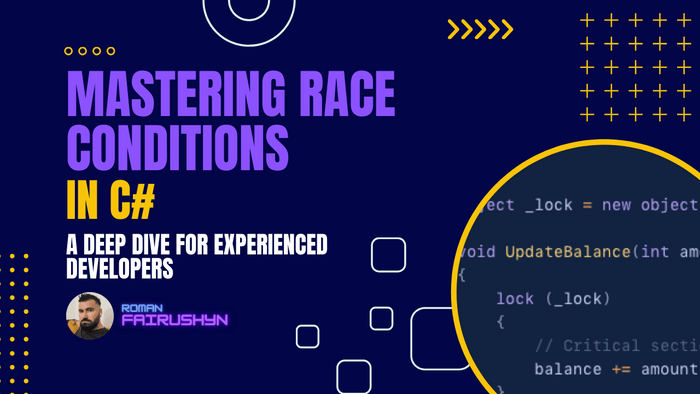Mastering Race Conditions in C#
A Deep Dive for Experienced Developers
3 min read · — #csharp-interview#senior#race-conditions
Introduction
Welcome to an in-depth exploration of race conditions in C#, tailored for seasoned developers looking to solidify their understanding in preparation for technical interviews. This post isn't just about definitions and theory; it's an adventure into the practical world of concurrent programming in C#. We'll dissect the concept of race conditions, demonstrate their occurrence in real-world scenarios, and discuss strategies to address them effectively.
Race conditions are a peculiar and often challenging aspect of concurrent programming. In the realm of C#, where multithreading and asynchronous programming are common, understanding race conditions is not just a matter of passing interviews, but a vital skill for crafting robust and reliable software. Let's dive into the world of race conditions, where timing is everything, and the slightest oversight can lead to unpredictable outcomes.
Understanding Race Conditions in C#
Definition and Basic Concept
A race condition occurs in a software system when the output or the behavior of the program depends on the sequence or timing of uncontrollable events. In C#, this typically happens in multithreading or asynchronous scenarios, where multiple threads operate on shared data.
Real-World Examples
Example 1: Banking Application
Consider a simple banking application where two threads are simultaneously updating the balance of the same account. Suppose the account starts with $1000.
- Thread 1: Withdraws $200
- Thread 2: Deposits $300
Ideally, the final balance should be $1100. However, if both threads read the initial balance at the same time, they'll both operate on $1000. Thread 1 might calculate the new balance as $800, and Thread 2 as $1300. Depending on which thread writes back last, the final balance could be incorrect.
Example 2: Logging System
Imagine a logging system where multiple threads log messages to the same file. If the system doesn't properly handle concurrent accesses, two issues can arise:
- Lost Messages: One thread's message might overwrite another's.
- Corrupted Format: Parts of messages from different threads could interleave, corrupting the log's format.
Strategies to Prevent Race Conditions
Locking Mechanisms
C# provides several locking mechanisms, such as lock, Monitor, Mutex, and Semaphore, to ensure that only one
thread can access a critical section of code at a time.
object _lock = new object();
void UpdateBalance(int amount)
{
lock (_lock)
{
// Critical section
balance += amount;
}
}Concurrent Collections
C# offers thread-safe collections like ConcurrentDictionary and BlockingCollection that manage concurrent accesses
internally, making them ideal for multi-threaded scenarios.
var logs = new ConcurrentDictionary<int, string>();
void LogMessage(string message, int threadId)
{
logs.TryAdd(threadId, message);
}Immutable Objects
Using immutable objects can also prevent race conditions. Once created, these objects cannot be modified, so concurrent reads are safe.
public class Account
{
public int Balance { get; }
public Account(int balance)
{
Balance = balance;
}
public Account WithDeposit(int amount)
{
return new Account(this.Balance + amount);
}
}Asynchronous Programming
Asynchronous programming patterns in C# can help manage concurrent operations more effectively, reducing the risk of race conditions.
async Task UpdateBalanceAsync(int amount)
{
// Asynchronous code to update balance
}Conclusion
Understanding race conditions in C# and knowing how to address them is crucial for developing robust, error-free applications. As you prepare for your technical interview, keep in mind that the ability to recognize and resolve concurrency issues is a skill highly valued in any experienced developer's toolkit. Happy coding!
